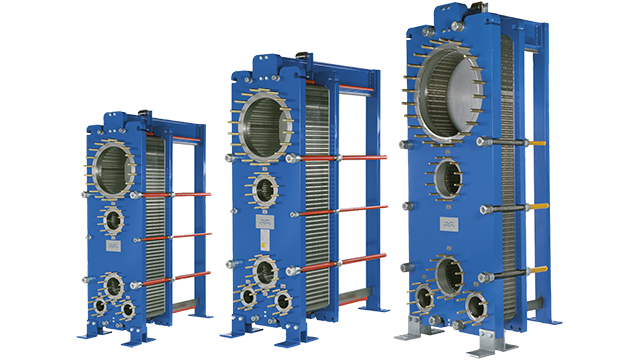Introduction
Caustic soda heat exchangers is designed to handle the heating or cooling of sodium hydroxide (NaOH), a highly corrosive and reactive chemical used in industries such as chemical manufacturing, pulp and paper production, textiles, and petroleum refining. These heat exchangers must be made from materials that can withstand aggressive chemical reactions while ensuring efficient heat transfer. Proper design and material selection are critical to prevent equipment failure, ensure safety, and optimize energy efficiency.
Key Factors in Caustic Soda Heat Exchangers
- Material Selection
- Caustic soda is highly corrosive, requiring materials that can withstand aggressive chemical reactions.
- Common materials include stainless steel (SS 316L, SS 304L), titanium, nickel alloys, Inconel, and graphite.
- Some heat exchangers use rubber-lined, PTFE-lined, or other non-metallic coatings to improve corrosion resistance.
- Choosing the wrong material can lead to rapid degradation, leaks, and increased operational risks.
- Heat Transfer Efficiency
- The exchanger must provide efficient heat transfer without hotspots or excessive fouling.
- Shell and tube heat exchangers and plate heat exchangers are commonly used due to their high efficiency.
- Proper flow arrangement (such as counterflow or crossflow) helps maximize heat transfer and minimize pressure drops.
- Temperature and Concentration Control
- Caustic soda becomes more corrosive at higher temperatures and concentrations.
- If temperature control is inadequate, crystallization can occur, leading to clogging in the heat exchanger.
- Precise monitoring systems and controlled heat exchange mechanisms help maintain stable operations.
- Scaling and Fouling Prevention
- Sodium hydroxide can react with air and impurities, forming solid deposits that reduce efficiency.
- Anti-fouling coatings, proper cleaning mechanisms, and smooth, non-reactive surfaces help reduce scaling.
- Regular maintenance and monitoring improve performance and prevent excessive buildup.
- Safety Measures
- Caustic soda is highly hazardous, requiring leak-proof construction to prevent chemical spills.
- Insulation is needed to prevent burns from heated surfaces.
- Double-walled exchangers or secondary containment systems enhance safety in industrial applications.
- Proper sealing, pressure regulation, and adherence to safety standards ensure safe operations.
Benefits of Caustic Soda Heat Exchangers
- Extended Equipment Lifespan
- Corrosion-resistant materials and coatings reduce wear and increase durability.
- Long-lasting performance lowers maintenance and replacement costs.
- Improved Heat Transfer Efficiency
- High-efficiency designs optimize heat exchange, reducing energy loss.
- Well-designed exchangers require less energy to achieve desired temperature changes.
- Safe and Reliable Operation
- Leak-proof designs and high-quality materials minimize risks of hazardous chemical exposure.
- Compliance with industry safety regulations ensures workplace safety.
- Reduced Downtime
- Easy-to-maintain designs allow for quick disassembly and cleaning.
- Regular maintenance helps industries maintain continuous operation with minimal interruptions.
- Energy Savings
- Optimized heat transfer reduces energy consumption and operational costs.
- High-efficiency heat exchangers use improved surfaces and optimized flow patterns to lower energy use.
Future Trends & Innovations in Caustic Soda Heat Exchangers
- Advanced Material Development
- New materials like ceramic coatings, fluoropolymer linings, and high-performance alloys enhance corrosion resistance.
- These innovations reduce maintenance costs and improve long-term reliability.
- Smart Monitoring & Automation
- IoT-enabled sensors provide real-time monitoring of temperature, pressure, and fouling levels.
- AI-based predictive maintenance detects early signs of wear, preventing failures and reducing downtime.
- Eco-Friendly & Energy-Efficient Designs
- Heat exchangers are being designed to minimize energy consumption and maximize heat recovery.
- Waste heat recovery systems help reuse excess heat, improving overall efficiency.
- Modular & Compact Designs
- Newer heat exchangers are designed to be space-saving yet highly efficient.
- Compact, high-performance units allow installation in small industrial setups.
- Self-Cleaning & Anti-Fouling Technologies
- Self-cleaning surfaces and advanced coatings reduce scale buildup and improve efficiency.
- Automatic cleaning mechanisms use chemical or mechanical cycles triggered by real-time data.
Conclusion
Caustic soda heat exchangers play a vital role in industries that require safe, efficient, and corrosion-resistant heat transfer solutions. Proper material selection, temperature control, and safety measures are crucial for ensuring long-term reliability and operational efficiency. The latest advancements in smart monitoring, energy-efficient designs, and advanced anti-corrosion materials are shaping the future of these heat exchangers. With increasing focus on sustainability and process optimization, innovations in caustic soda heat exchanger technology will continue to improve performance, safety, and energy efficiency.

